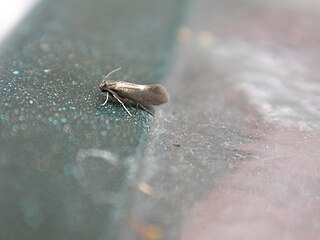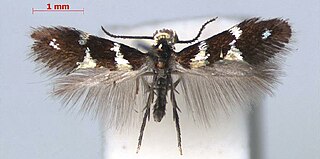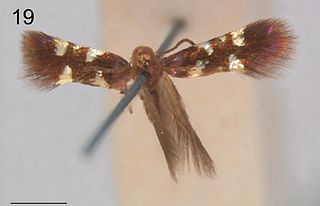
A family of primitive monotrysian moths in the order Lepidoptera, Heliozelidae are small, metallic day-flying moths with shiny smooth heads. In Europe the small adult moths are seldom noticed as they fly quite early in the spring. The larvae are leaf miners and the vacated leaf mines are distinctive because the larva leaves a large hole at the end.

Antispila treitschkiella is a species of moth of the family Heliozelidae. It is found from Great Britain to Ukraine and from Sweden to France, Italy and Greece. It is also found in Portugal.

Antispila oinophylla is a species of moth of the family Heliozelidae. It is found in North America, including Ontario, Quebec, Connecticut, Georgia, Kentucky, New York, Tennessee and Vermont. Records under Antispila ampelopsifoliella from Maine, Missouri and Ohio may also partly refer to this species. In Europe, it is introduced into northern Italy.

Antispila ampelopsifoliella is a species of moth of the family Heliozelidae. It is found in eastern North America, including Connecticut, Kentucky, New York, Vermont and Ontario.Records from Italy may refer to Antispila oinophylla.

Antispila voraginella is a species of moth of the family Heliozelidae. It is found in the Rocky Mountains, including Utah, Arizona and western Texas.

Antispila hydrangaeella is a species of moth of the family Heliozelidae. It is widespread in the eastern United States, including Georgia, Illinois, Kentucky and North Carolina. However, research suggests that two species might be involved under this name.

Antispila viticordifoliella is a species of moth of the family Heliozelidae. Research suggests that two species might be involved under this name, one feeding on Vitis species which is found in Kentucky and Pennsylvania and the other on Parthenocissus species, which is found in Ontario, Connecticut, Florida, New York and Vermont.

Antispila isabella is a species of moth of the family Heliozelidae. It is found in Ontario, Connecticut, Georgia, Kentucky, New York, Pennsylvania and Vermont. However, research concludes that a complex of species is involved under this name.
Antispila purplella is a moth of the family Heliozelidae. It was described by Kuroko in 1961. It is found in Japan (Kyushu).

Antispila aristarcha is a moth of the family Heliozelidae. It was described by Edward Meyrick in 1916. It is found in India.
Antispila cleyerella is a moth of the family Heliozelidae that is endemic to Japan.
Antispila inouei is a moth of the family Heliozelidae. It was described by Kuroko in 1987. It is found in Japan.
Antispila isorrhythma is a moth of the family Heliozelidae. It was described by Edward Meyrick in 1926. It is found in India.
Holocacista pariodelta is a moth of the family Heliozelidae. It was described by Edward Meyrick in 1929. It is found in India.

Holocacista salutans is a moth of the family Heliozelidae. It was described by Edward Meyrick in 1921. It is found in Zimbabwe and the South African provinces of KwaZulu-Natal and Limpopo.
Antispila tateshinensis is a moth of the family Heliozelidae. It was described by Kuroko in 1987. It is found in Japan.
Antispila uenoi is a moth of the family Heliozelidae. It was described by Kuroko in 1987. It is found in Japan. In 2018, the species was found from China.
Heliozela limbata is a moth of the family Heliozelidae. It was described by Lee, Hirowatari and Kuroko in 2006 and is endemic to Japan.

Holocacista varii is a moth of the family Heliozelidae. It was described by Wolfram Mey in 2011. It is found in South Africa.

Holocacista capensis is a moth of the family Heliozelidae. It was described by van Nieukerken and Geertsema in 2015. It is found in South Africa.








